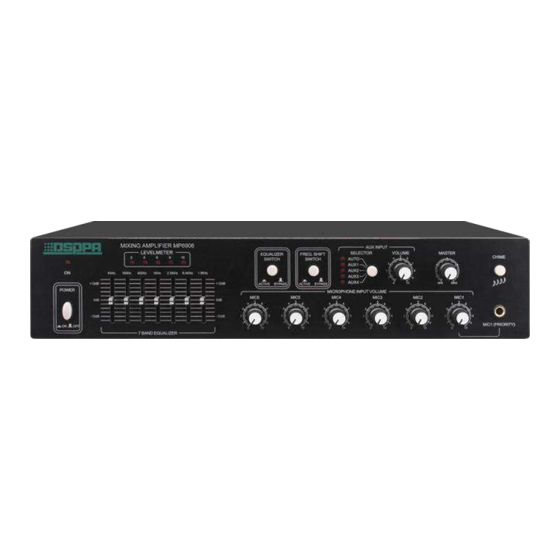Advertisement
Quick Links
Description
PA Conference System MP69 Series Amplifier is a PA amplifier series product integrating the equalizer,
frequency shift, pre-amplifier and power amplifier. The series provides 4 audio source input ports, 6
microphone input ports, 1 line output port and 4 amplifier output terminals. Among them, the volume of 4
audio source channels can be individually controlled with the channel selection function, the volume of 6
microphones can be controlled independently, and the amplifier output volume can be controlled by the
master control. It has 7-band EQ to adjust the output.
MP69 series products have 100 V and 70 V rated voltage output, and P1 output. They are divided into four
models based on power, including 60W(MP6906), 120W(MP6912), and 350W(MP6935).
Features
Convenient and reliable working mode, integrated functional design.
4 LINE IN, 1 LINE OUT, 6 MIC IN (Balanced, ungrounded, with 24 V phantom power supply).
Can automatically detect the input status of 4 audio source channels after powered on, and output the
signal with the higher priority first.
The priority of the 4 audio source channels: AUX1, AUX2, AUX3, AUX4.
With mute function, easy to override the normal playing.
Adopt DSP frequency shift processing for the microphone, with frequency shift function.
With built-in chime generator, adjustable chime output volume.
With independent volume control for microphones and audio source channels, and master volume
control for amplifier output.
7-band EQ, easy for adjustment, with EQ/Bypass option for output.
With 100 V and 70 V rated voltage output, P1 output.
Specifications
Model
Rated Output Power
Output Voltage Regulation
conference@dsppa.com
MP6906 MP6912 MP6935
PA System Conference Amplifier
MP6906
MP6935
MP6906
60W
/
www.dsppacs.com
MP6912
120W
From full load to no load, ≤3dB
The specifications will be subject to change without prior notice.
Copyright © Guangzhou DSPPA Audio Co., Ltd. All rights reserved.
MP6912
Rear Panel
MP6935
350W
Advertisement

Summary of Contents for DSPPA MP6906
- Page 1 It has 7-band EQ to adjust the output. MP69 series products have 100 V and 70 V rated voltage output, and P1 output. They are divided into four models based on power, including 60W(MP6906), 120W(MP6912), and 350W(MP6935). Features ...
- Page 2 (5) MIC4 volume adjustment knob. Rotate clockwise to turn up the volume, and counterclockwise to turn down the volume. conference@dsppa.com www.dsppacs.com The specifications will be subject to change without prior notice. Copyright © Guangzhou DSPPA Audio Co., Ltd. All rights reserved.
- Page 3 “OFF”, the phantom power supply will be turned off. (9) Built-in cooling fan. The working voltage is 12V. conference@dsppa.com www.dsppacs.com The specifications will be subject to change without prior notice. Copyright © Guangzhou DSPPA Audio Co., Ltd. All rights reserved.
- Page 4 (11) P1 output terminal. Can connect several speakers in parallel, but requiring that the total impedance should not be lower than 4Ω. (12) 70V rated voltage output terminal. (13) 100V rated voltage output terminal. conference@dsppa.com www.dsppacs.com The specifications will be subject to change without prior notice. Copyright © Guangzhou DSPPA Audio Co., Ltd. All rights reserved.

















Need help?
Do you have a question about the MP6906 and is the answer not in the manual?
Questions and answers